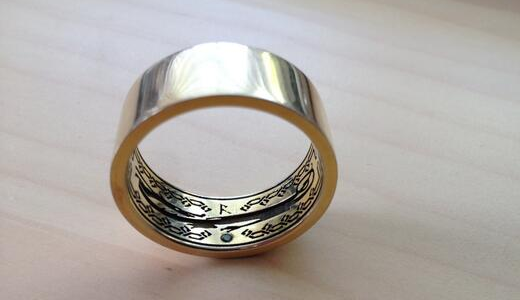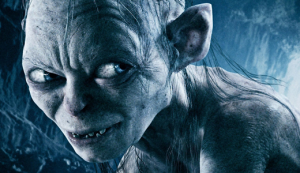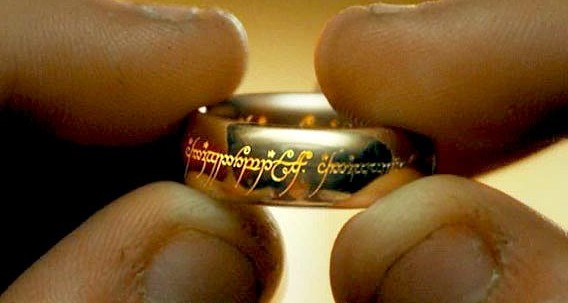History’s ‛Rings of Power’
Twenty Rings of Power – but only one held dominance over the rest. Residing at the heart of The Lord of the Rings, the One Ring is one of the most crucial aspects of the entire story. Yet, like many other subjects in the novel, it is surrounded by ambiguity and speculation.

The actors who played the thirteen dwarves in The Hobbit commissioned special rings with the story of their quest engraved on the inside. Actor Stephen Hunter shared photos of his ring on Twitter.
Historically, rings have been worn as ornaments on the human body for thousands of years. However they were also a symbol of supremacy used by reigning kings and queens, especially during the Middle Ages. Even the position of the ring on the finger had a specific significance. A common practice was the wearing of such an artefact on the forefinger which, according to astrological studies, is a sign of command and power – indeed emphasizing a ring of power.
In The Lord of the Rings, it is rarely stated on which finger each bearer wore the Ring. Nonetheless, there are a few clues that point towards the occasional use of the left forefinger, such as when the item eventually passes on to Frodo. In The Fellowship of the Ring, we read how the hobbit “slipped the Ring on the forefinger of his left hand” (‛A Knife in the Dark’, Book 1, Chapter IX). The use of the forefinger thus seems to have been of particular significance even within the context of Tolkien’s One Ring. Nevertheless, in other instances, such as the climax of the story in The Return of the King, Frodo is missing his middle right finger, indicating that the Ring had been worn on this particular finger.
Wielding the One Ring
In order to better understand the relationship between the Ring and its bearer, one must also look at what the author had to say about this bond, beyond the novel itself. In one of his many letters Tolkien wrote:
The Ring of Sauron is only one of the various mythical treatments of the placing of one’s life, or power, in some external object […] it was a mythical way of representing the truth that potency (or perhaps rather potentiality) if it is to be exercised, and produce results, has to be externalized and so as it were passes, to a greater or lesser degree out of one’s direct control.
(Letter No. 211, The Letters of J.R.R Tolkien)
 It is therefore clear that depending on both the mental and physical strength of the individual, the Ring granted varying degrees of power according to how it was used. By wielding the One Ring, individuals would put their life in the hands of a material object – an exterior entity and an extension of themselves.
It is therefore clear that depending on both the mental and physical strength of the individual, the Ring granted varying degrees of power according to how it was used. By wielding the One Ring, individuals would put their life in the hands of a material object – an exterior entity and an extension of themselves.
One of the powers granted by wearing the Ring was to make the wearer invisible. This occurs with almost every character that had possession of the One Ring – from Isildur to Gollum, Bilbo to Frodo, and also Sam. One crucial scene in The Return of the King may offer us the opportunity to speculate on the Ring and its connection to the body in conjunction with invisibility. As the two hobbits find themselves within Mount Doom, a struggle ensues between Gollum and an invisible Frodo for possession of the Ring:
Suddenly, Sam saw Gollum’s long hands drawn upwards to his mouth; his white fangs gleamed, and then snapped as they bit. Frodo gave a cry, and there he was, fallen upon his knees […] But Gollum, dancing like a mad thing, held aloft the ring, a finger still thrust within its circle.
(‛Mount Doom’, Book 6, Chapter III, The Return of the King)
From this passage, the reader may come to the conclusion that once the Ring is detached from the physical body of the individual, then that connection is severed and all power (in this case, of invisibility) is lost. But one can also question whether it is the finger bearing the Ring which channels the powers to the wielder and thus renders the body invisible. As we read from the above text, once Gollum severs the finger – with the Ring still attached to it – the finger is visible.
There is also a symbolic meaning to Frodo being made visible again. The issue of “potency” brought up by Tolkien in his letter (above) resonates strongly in this scene. The hobbit, as he wears the Ring (the external object), has surrendered his life source to it and once the finger is severed and the link lost, this “potency” is no more – the ability of being invisible is forbidden and the power of the Ring is no longer being transferred to the wielder. This loss of potency to an external object enables Frodo to shed its evil influence.
At the same time, this argument may pose two more questions:
– Is the Ring intentionally exposing itself?
– Or is it simply the lack of a physical link to the bearer?

This might sound ludicrous to some and may pass off as something deeply philosophical and the result of an over-analytical mind, but it is nonetheless evident that Tolkien wanted to strongly convey his ideas about surrendering one’s body to an exterior force. Furthermore, throughout The Hobbit and The Lord of the Rings, the One Ring is clearly a character – or at least, a force – of its own, often slipping on and off fingers in order to suit its own needs and find its way back to its creator.
The scene at Mount Doom seems to point towards the Ring’s last desperate attempt at being claimed by Sauron. Here you have two characters taken over by its power, who are struggling against each other. Once Gollum bites Frodo, the Ring exposes itself on the finger and presents itself to a much weaker character who would succumb to it far more easily than Frodo.
Final Thoughts
This discussion poses a set of very intriguing and complex questions about the nature of the One Ring and how it works as an object of guile and power. To the questions asked above there is no definite answer, but Tolkien continues to emphasize the dangers of placing ourselves in the hands of some external being. It is ultimately the individuals’ internal will and strength that determine their passage through life.


